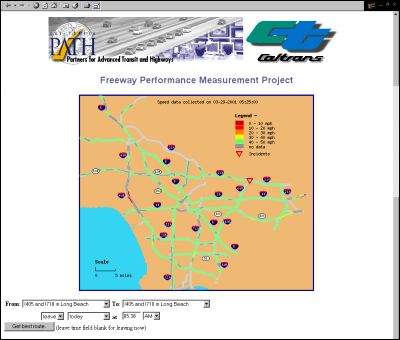|
Week of March 26, 2001 Editor's Choice Web Pick |
 California's PEMS Site Provides Future Peek at Online Anti-Gridlock Weapon
California's PEMS Site Provides Future Peek at Online Anti-Gridlock Weapon
By JACK LYNE • Site Selection Executive Editor of Interactive Publishing
ABOVE: PEMS's maps and charts skew toward the predictive.
Sensors Paving Route Out of Traffic Hell? The road to traffic hell is partially paved with freeways and single-use zoning. In-road sensors, though, could help pave the road out, this site suggests.What's enabling the pioneering PEMS system is the sensor network that the California Dept. of Transportation (Caltrans at www.dot.ca.gov) has embedded in much of the state's vast freeway system. (PEMS is supported by Caltrans and by the National Science Foundation through California Partners for Advanced Transit and Highways (PATH), a public/private effort to use advanced technology to reduce traffic congestion, air pollution and energy consumption.) Marked by circles or squares and thick black lines painted across the freeway, the sensors are implanted every one-third to one-half mile (0.56 to 0.85 km.). The detectors are also installed on many on- and off-ramps, and at many busy city intersections. System Debuts in Southern California  The PEMS system currently operates only in Southern California, widely acknowledged as home to some of the nation's thorniest gridlock. "A 40-mile (68-km.) trip can take anywhere between 50 and 130 minutes during rush hour," Pravin Varaiya, the UC Berkeley professor who developed PEMS, said by way of example. The PEMS system currently operates only in Southern California, widely acknowledged as home to some of the nation's thorniest gridlock. "A 40-mile (68-km.) trip can take anywhere between 50 and 130 minutes during rush hour," Pravin Varaiya, the UC Berkeley professor who developed PEMS, said by way of example.
Here's how the system works: Sensor data from Caltrans' Los Angeles district office shoot through a high-speed data link to UC Berkeley's EECS Dept., which maintains a huge database to track and analyze the input. That database has to be huge. Los Angeles traffic generates one gigabyte of data per day, Varaiya noted. The PEMS site converts that huge data glob into online maps, charts and graphs, all skewed toward the predictive. "When we take to the roads today, we're already making our own predictions,"
says Varaiya, the UC Berkeley professor who developed PEMS. "When we tell people we can predict their travel time on congested freeways, they are frequently skeptical," Varaiya noted. "We know we cannot predict an accident that may happen 10 minutes into our trip, even if we collected all the data in the world. No prediction can be 100 percent accurate. But they can be useful. When we take to the roads today, we're already making our own predictions." Using computer algorithms, the PEMS system takes current travel times and makes the leap into the future. That leap, though, entails inescapable uncertainties, Varaiya allowed. "We may be calculating the speeds everywhere up to the current time, but we don't know what the speeds will be at a location when the vehicle gets there," he said. "Therefore, we have to predict what the speeds will be for a trip that hasn't happened yet." Does More Efficiency Mean The site, however, claims major predictive improvements. For the aforementioned 40-mile, 50-130 minute trip, for example, PEMS's prediction error is about 12 minutes, Varaiya noted. By comparison, the prediction error is 25 minutes using only the current measurements and "more than 30 minutes" using only historical information, he said. So what does PEMS's work in progress mean? As such systems become more precise, it could mean a lot. Varaiya, for example, contended, "The solution to traffic congestion doesn't lie in building new highways. It lies in more efficiency." PEMS-like sites could put a major dent in gridlock by helping people adjust travel times for the fastest flow, he said. Conceivably, that could make some gridlock-plagued areas far more feasible as facility locations. PEMS-like systems might also provide expansion planners with far more useful historical data in assessing potential sites. Official: Potential Savings for LA of $1.5 Billion Areas that boast such systems would probably also reap a bump up in site selection appeal. Better Los Angeles-area traffic management, for instance, would yield fuel and travel-time savings of $1.5 billion, Varaiya estimated.As for PEMS in particular, the site is expanding in a number of ways. Northern California is in the process of implementing its own PEMS system. Future plans also include making PEMS available to Palm Pilots and Web-enabled cell phones, Varaiya reported. Ever-escalating gridlock, however, means near-term obsolescence for even such a cutting-edge system. Varaiya said that PEMS's technology can only accommodate future demand for "the next five years." Long-term solutions require even more high-powered tools, he contended, particularly automated vehicle guidance systems. Expect the Web to also carry some heavy traffic in driving those systems. |
 PLEASE VISIT OUR SPONSOR • CLICK ABOVE
PLEASE VISIT OUR SPONSOR • CLICK ABOVE 
©2001 Conway Data, Inc. All rights reserved. Data is from many sources and is not warranted to be accurate or current.